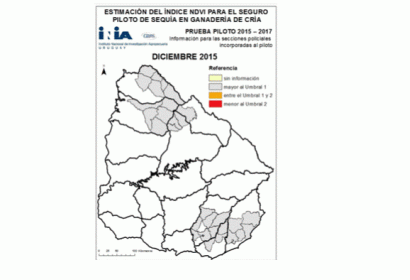The Ministry of Agriculture, Livestock and Fisheries of Uruguay (MGAP) launched in December 2015 a three-year long pilot project to test the viability of a drought insurance scheme based on the Normalized Difference Vegetation Index (NDVI). The pilot project will benefit individual cattle farmers and is being implemented by the Agriculture Policy and Planning Office (OPYPA) of MGAP. The pilot project is one of the efforts carried out by MGAP in the context of adaptation to climate change and benefited from the conclusions and recommendations of a feasibility study conducted by the World Bank on this topic between 2011 and 2013. According to this feasibility study, recent developments regarding the NDVI offer the possibility to use it in insurance programs targeting rain-fed pastures against climate risks such as droughts.
Technical support regarding the continuous monitoring of the NDVI in Uruguay is provided by the Agro-climate and Information System Unit (GRAS) of the National Agricultural Research Institute (INIA). GRAS supports MGAP through the estimation of the NDVI and its subsequent publication during the period from spring to summer. Information on the role of GRAS of INIA can be found in this link: http://www.inia.uy/investigaci%C3%B3n-e-innovaci%C3%B3n/unidades/GRAS/seguro-de-sequ%C3%ADa
The NDVI-based insurance pilot project is being tested in the Basalto and the East Hills regions of the country. This NDVI-based insurance pilot project makes use of two thresholds established on the basis of the deviation of the NDVI from its average value. These triggers would be used to define severe and very severe droughts.

